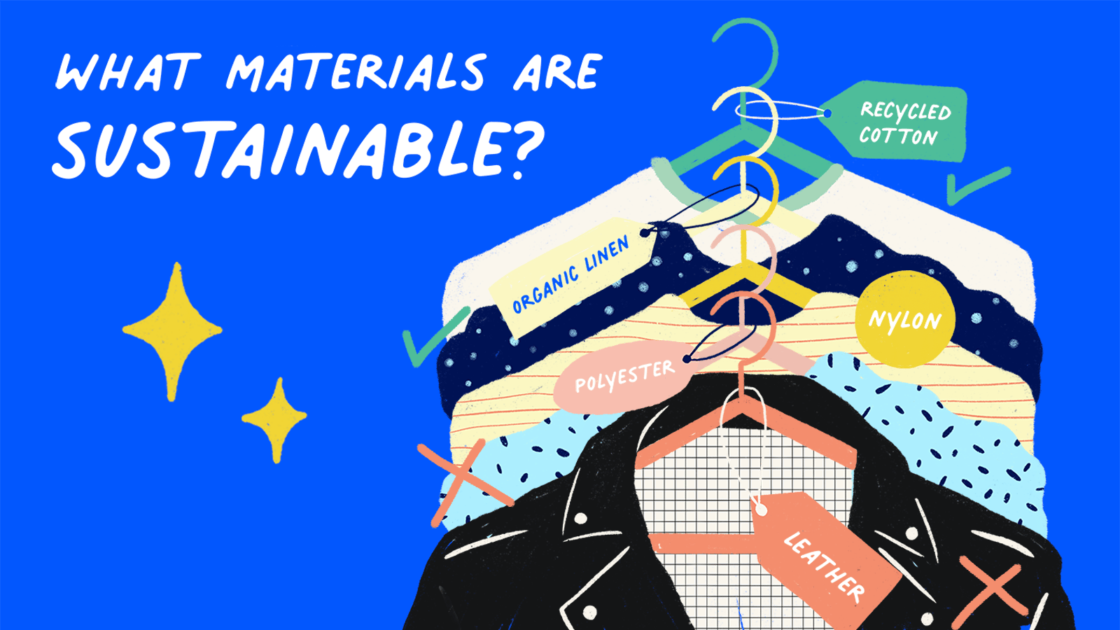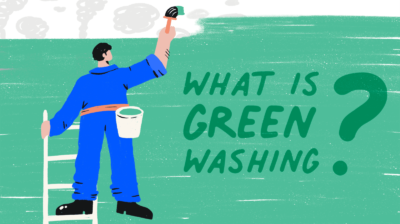What materials are sustainable?
Synthetic and natural fibres are not necessarily good for the environment, click here to see what materials are good for the planet.


Many people are becoming more conscious of the impact of their clothes on the planet. Looking at what materials your clothes are made from is one way to make more sustainable clothing choices.
What’s wrong with synthetic fibres?
Human-made materials or synthetic materials can be toxic to the environment and often take much longer to biodegrade. Opting for more sustainable materials means that the clothes you own will have less of an impact on the environment as you wear and wash them.
Synthetic material and microplastics
Clothes made of synthetic materials like polyester release tiny particles called microplastics when you wash them. Washing synthetic clothes is responsible for 35% of microplastics in our environment.
These microplastics can pollute waterways and end up in our food when they get eaten by the animals we consume. It’s okay if you own things made of synthetic materials, but don’t forget, washing them less can help minimize their impact on the environment.
Are natural fibres more sustainable?
While natural fibres like cotton and linen are more biodegradable and compostable, they can also have a very wasteful production process. For example, it takes around 2,700 litres of freshwater to produce one cotton t-shirt. Cotton requires a lot of chemical pesticides to grow which negatively impacts people who grow the cotton as well as the planet. Materials like leather, bamboo and wool are also natural fibres with complications.
This is why it’s important to try and cut down on the number of new clothes you buy, to use the clothes you already have to their maximum potential, and to shop second hand.
What clothing materials are sustainable?
If you are buying new, one way you can make more sustainable fashion choices is to look at the materials that clothes are made from. You can find out more about this by looking at the label on each item of clothing.
Here are some materials to look out for:
Recycled cotton
Growing and manufacturing cotton requires a large amount of water, chemicals and pesticides. However, one of the most sustainable materials you can get is recycled cotton. It uses cotton waste from both factories and used clothing. It’s made using less water and energy and helps keep existing cotton out of landfills.
Recycled cotton, like all cotton, won’t produce harmful microplastics when you wash it. It also gets points for contributing to a circular fashion industry.
Organic cotton
While organic cotton still uses a lot of water it removes harmful pesticides and other chemicals from its production. Global Organic Textile Standard (GOTS) certified organic cotton is a label that ensures that the manufacturing of the cotton doesn’t use fertilisers and pesticides that are harmful to the environment or workers. The Better Cotton Initiative (BCI) is another mark to look for when buying clothes. It helps farmers care for water, soil health and natural habitats.
Organic Linen
Linen has been used as clothing for centuries, as far back as ancient Egypt. It comes from the flax plant which can grow in low-quality soil with minimal water and pesticides. It is actually good for soil health.
If there are no dyes in the material it is fully biodegradable too. It’s super lightweight and absorbs moisture, making it great for summer. It can sometimes be expensive, but it is very durable and so will last a long time, saving you money in the long run. It’s also very quick to dry.
Organic Hemp
Hemp grows very fast, and similar to linen it requires very little water, no pesticides and is a natural soil fertilizer – most hemp you find should be organic for this reason and won’t need certification as long as it is not mixed with another material. It feels similar to linen and gets softer as you wash it. It’s also cool in the summer and warm in the winter.
Tencel
TENCEL® is a brand name for a material made by Lenzing AG, an Australian company. Tencel is short for Tencel Lyocell which is made from dissolved wood pulp. It is a type of rayon (a synthetic fibre made from natural sources) but is different from other wood pulp products like viscose.
Usually, making viscose (or rayon) uses a lot of chemicals, including sodium hydroxide (also called lye) which can be harmful to workers and the environment. However, Tencel uses a process of less intense chemicals in a closed-loop solvent system, meaning the chemicals are reused over and over. This means there is less waste going into the environment, 99% of the solvent used is recovered.
Other materials
Other new sustainable materials like Piñatex, Econyl and Qmonos can be good choices too. Just make sure to check what other materials they’re mixed with and whether the company selling them is transparent about their sourcing and production methods. They can be a bit pricey too, making them less accessible.
If you can stretch your budget a little further but are buying new, going for good quality clothing can help reduce your impact on the planet too. If more sustainable materials are out of your price range right now, remember that buying second-hand is another sustainable way to buy clothes.
Are all natural materials good for the environment?
While natural fibres are more biodegradable and create fewer microplastics, some bring other issues to the table regarding sustainability and ethics.
Bamboo and wood pulp materials
Bamboo is another fast-growing crop that needs no fertiliser and grows again from the same root once it is harvested. However, there is little information about what kind of land is cleared to harvest bamboo and how intensively it is farmed. This means bamboo could contribute to deforestation, when trees are removed to make room for something else – in this case, to plant bamboo. This can have an impact on animals, humans, biodiversity and the environment.
The silky bamboo material we see in towels, sheets and underwear is mostly made from bamboo rayon. This is made in the same harmful process as most rayon or viscose (synthetic fibres made using natural sources, which requires the use of harmful chemicals). Tencel is a better option when it comes to wood pulp material with a similar feel.
Leather
The main issue with leather is that it comes from the livestock industry, which creates 14.5% of human-induced greenhouse gas (GHG) emissions, according to the UN. The agriculture industry clears large amounts of land to make room for livestock such as cattle – it’s estimated to be responsible for around 80% of deforestation worldwide, according to the Wageningen University and Research Centre. These animals are not always treated well either, as in many places where leather is produced, animal welfare laws for food or leather cattle are minimal.
The processing of leather is also very harmful to the environment. A large number of toxic chemicals are used in the process of tanning leather – the equivalent of about a third of the weight of the leather itself. It also takes up to 17,000 litres of water to produce a kilogram of leather (not far off cotton, which takes 20,000 litres).
The chemicals used in making leather also negatively affect the people making it and locals living near tanneries. Leather is often made in countries where laws on protecting people and the environment from the impact of leather production are lacking.
Second hand and recycled leather are a good way to add leather to your wardrobe in an ethical and sustainable way. You can also research companies that are making an effort to reduce the damage caused by their manufacturing process.
Wool
Wool is biodegradable, renewable, cool in summer, warm in winter, stain-resistant and easy to care for. However, not all countries have high standards of animal welfare for sheep.
The growing of sheep’s wool for human consumption has led to sheep overheating, therefore, attracting flies who lay eggs in the folds of sheep’s skin and in turn this can potentially kill many sheep. Mulesing is a process that is taken to remove these flies and eggs, however, this is incredibly painful for sheep and can result in them being in pain for over 24 hours. The main issue here is with the methods used to produce a huge volume of wool, making this production not very sustainable and raising questions around the ethical nature of using wool fibres.
Large scale sheep farming can also have a negative impact on the environment as it can involve clearing land and can damage the soil. There are sustainable ways to farm sheep that use smaller plots of land and move the sheep around frequently.
When buying wool, try going second hand (since it’s such a durable material). When buying new, look for recycled wool or ethical wool certificates like Responsible Wool Standard, ZQ Merino Standard and the Soil Association Organic Standards.
It is important to remember that big changes in leather, cotton, wool and synthetics industries are necessary to create a more sustainable and ethical world. Making sustainable clothing choices can make a difference, but sharing your knowledge and campaigning for better standards can help contribute toward a more ethical and circular fashion industry.
Cover image by Cathy Hogan






